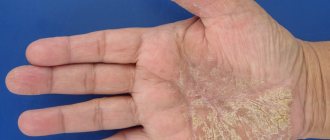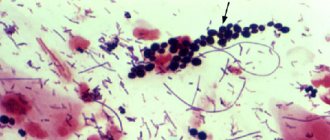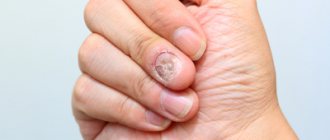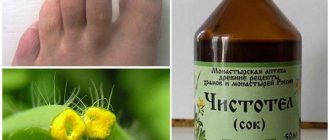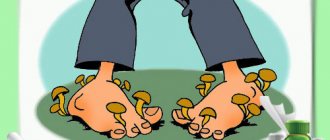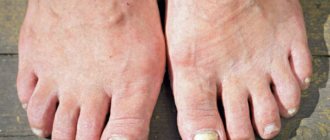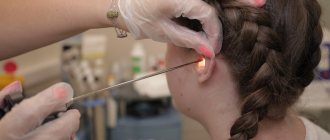Fungus between the fingers occurs when the skin is infected with fungi of the genus Candida. This type of disease is called superficial candidiasis. Other names for the infection are candidiasis of the interdigital folds, interdigital yeast erosion.
More than 150 species of fungi of the genus Candida are known, but the following types of microorganisms are pathological pathogens:
- Candida albicans – in 84% of cases;
- Candida parapsilosis – 9%;
- Candida tropicalis – 2%;
- Candida krusei – 2;
- Candida glabrata – 1%.
The fungus of the genus Candida has a different structure depending on the type of microorganism. Colonies of these fungi grow quickly (on average 3 days), can be different in color (from yellowish to white), and in consistency - smooth, rough, velvety.
Candida albicans is considered the most common and best-studied causative agent of candidiasis. The source of infection of this type of fungus is colonies on the patient’s own mucous membranes. C. albicans is the most pathogenic fungus of this genus. But it is also more treatable and has the best initial sensitivity to antifungal drugs.
Photo: Ternavskaia Olga Alibec / Shutterstock.com
Symptoms, signs and diagnosis
It is very important not to miss the first signs of fungus on the hands, which are expressed:
- Peeling of the skin and persistent itching;
- Peeling of the skin, especially between the fingers;
- The appearance of bubbles and swellings in areas affected by mycosis;
- Increased sweating of the palms;
- Changes in skin structure, deformation of nails;
- Various spots on the nails and their peeling;
- Since the fungus can penetrate the human body, pain in different organs is possible.
Diagnosing fingernail fungus is the task of a dermatologist. You should not diagnose yourself and try to solve the problem alone, as this requires taking a scraping for laboratory testing.
Causes of candida infection
In the external environment, fungi of the genus Candida are found:
- in soil and water contaminated with human and animal excrement;
- on food products - raw meat, fruits, juices, cottage cheese, milk;
- on household items.
This is an opportunistic fungus: in people with a healthy immune system, it is found in the mouth and nose, in the vagina in women, and on the mucous membrane of the digestive tract. There is no fungus in sterile body fluids (blood, cerebrospinal fluid, bile).
Primary colonization of the child’s body by fungi occurs in the mother’s birth canal, and after birth, infection occurs through contact: infection from other people, through household items. In adults, infection can occur through sexual contact. The internal cause of the development of candidiasis infection is severe immunodeficiency conditions, diabetes mellitus, endocrine pathologies.
The main cause of candidal fungus of the skin and nails is a violation of the barrier function of the skin. This can occur with chronic skin diseases: eczema, atopic dermatitis, seborrheic dermatitis, psoriasis. There is an opinion that the prevalence of yeast-like fungi is increased in people with allergic dermatoses. Fungi of the genus Candida are more often isolated in individuals with severe atopic dermatitis. Increased levels of Candida fungus are found in patients with psoriasis.
Photo: Iris_AN / Shutterstock.com
Clinical cases of candidiasis among patients with chronic skin diseases can be explained by the result of the development of immunodeficiency states against the background of chronic diseases, the use of antibiotics, immunosuppressive and hormonal drugs in the treatment of these diseases.
Fungus between the fingers is an occupational disease for those people who have contact with water and food products: confectioners, dishwashers, cleaners.
Photo: sukiyaki / Shutterstock.com
Treatment of fungus on hands
It is necessary to begin treatment with laboratory tests to determine the type of fungal disease. The study will allow us to determine the necessary and effective drug that will successfully combat the detected type of pathogen. In the early stages, mycosis can be successfully treated with antifungal medications - sprays, lotions, creams and ointments. All of these medications have contraindications, so before starting treatment, you need to consult your doctor and follow his instructions.
Fungus on hands photo
Treatment prognosis and infection prevention
The prognosis for interdigital fungus on the hands is favorable. With the right approach to the problem, recovery occurs within a few weeks, or at most a few months. It depends on the severity of the problem.
It is very simple to prevent interdigital fungus on healthy hands. To do this you need:
- use only personal towels and manicure tools, and children only use their own toys;
- refuse to shake hands if a person has symptoms of fungus on their hands;
- if possible, avoid touching handrails and door handles in public places with bare hands;
- observe the rules of hygiene;
- Immediately treat wounds on your hands with antibacterial agents.
You also need to monitor your immune system. It is very important to avoid stress, eat right, exercise, exercise, sleep enough hours, and treat illnesses in a timely manner. The fungus will not affect an absolutely healthy person.
Pharmacy remedies for fungus on hands
help well in treating fungus on the hands . To be effective, they need to remain on the affected area for as long as possible. For this purpose, medicinal varnish is also used. Loceryl and Batrafen are considered the most effective: before using them, you need to remove the infected piece of nail with a file or nail clippers.
In the early stages of the disease, it is good to use patches with a peeling effect. When used, the affected area of the nail softens and can then be easily removed. It contains salicylic acid, urea, an antiseptic and an antifungal agent. This patch is wrapped in a simple plaster, left for a couple of days, after which the procedure is repeated. Such treatment will require at least six months.
Fungus on the fingers or between the fingers is treated with medical formulations according to prescriptions, which you can make yourself, knowing the exact composition of the medications. They usually contain vinegar essence, sulfur, iodine, salicylic and lactic acid, brilliant green and blue. Treatment with such drugs is quite long-term and can last more than a year.
New drugs are now available that actively destroy the fungus. The duration of treatment with these drugs is from 2 to 4 months. The most effective is pulse therapy, which lasts only a few weeks. Common medications for oral administration are tablets and capsules. But all drugs can be used only as prescribed by a doctor.
Medicines for mycosis:
- Diflucan
- Mycohepitn
- Clotrimazole
- Fluzol
- Fluconazole
Ointments and solutions:
- Levorin ointment
- Griseofulvin
- Triderm
- Nystatin ointment
- Mycozolon
The danger of mycosis
Interdigital fungus is a dangerous condition.
The symptoms of the disease may differ in each individual case. It is recommended to contact a specialist at the first unpleasant manifestations to establish an accurate diagnosis and prescribe the correct therapy.
If left untreated, it can lead to the following consequences:
- spread of infection (fungus on the fingers spreads to nearby skin, and then to internal organs);
- decreased immunity;
- addition of a bacterial infection;
- exacerbation of chronic diseases;
- allergic reactions;
- intoxication of the body (during the process of vital activity, mushrooms produce harmful substances, which then enter the blood).
Traditional medicine against fungus on hands
such remedies for fungus on the hands , the most effective ones are listed below.
Coffee:
- Brew strong coffee without throwing away the sediment.
- Several times during one procedure, lower and hold your hands in warm coffee.
Hot pepper:
- Cut off the bottom of the hot pepper, remove the seeds.
- Pour strong vodka into it.
- Dip the affected finger into the vodka, being careful not to let the vodka spill out.
- Leave for 10-20 minutes, remove the finger and bandage it.
- The bandage must be left overnight.
The process is very painful, but recovery occurs quickly.
Sea salt baths:
- Add 2 tbsp to 2 liters of warm water. l. salt. Mix.
- Systematically hold your hands in a warm solution for 20 minutes a day.
hand fungus
Preventive measures
The best treatment for a disease is prevention. By following simple rules, you can reduce the risk of mycosis several times. First of all, it is necessary to maintain hand hygiene and use antibacterial soap for washing several times a day. Always use gloves when doing household work. Treat any abrasions and scratches with an antiseptic solution in a timely manner.
It is necessary to monitor your general health and take vitamins to boost your immunity. All personal hygiene instruments must be thoroughly disinfected . You should never wear someone else's gloves or use towels in public places. Linen should be washed at a temperature of 90° C. This is when the fungal spores die.
At the slightest suspicion of a fungus, you should immediately contact a dermatologist . Compliance with all the rules will guarantee that fungal infections will not arise or appear again.
Prevention
We should never forget that mycosis is a contagious disease, and if one family member is infected, then, as a rule, everyone else becomes infected. Therefore, you must always strictly follow the rules of hygiene:
- Do not use someone else’s shoes and do not give yours to anyone;
- The infected family member should have separate manicure supplies;
- If you are infected, do not walk around your apartment barefoot.
- Perform daily disinfection of everything the patient has touched;
- Try not to wear socks and tights for a long time.
In order not to become infected with such an unpleasant disease, you should try to avoid visiting public health centers - baths, showers and swimming pools. Carefully monitor personal hygiene and prevent fungal diseases, and immediately consult a doctor at the first symptoms.
Causes of fungal infection
The disease is caused by 2 pathogens - dermatophytes and yeast fungi of the genus Candida. Infection occurs in public places, through contact with a sick person and when personal hygiene rules are not followed.
There are a number of reasons that contribute to infection of the fungus between the fingers :
- weakened immune system;
- pregnancy;
- poor nutrition;
- stress;
- chronic diseases;
- endocrine pathologies;
- disruptions in the functioning of the cardiovascular system;
- constant work in water.
Some of the most common places for contracting this disease are swimming pools, saunas, gyms and nail salons. When visiting these establishments, you must strictly follow the rules of hygiene.
Fungus between fingers: symptoms
Candidiasis of the interdigital folds affects the skin between the fingers, most often on the hands. Most often, the fungus is located in the narrowest – third and fourth – folds between the fingers. As a rule, bilateral lesions or lesions of the right hand predominate.
Against the background of redness, bubbles form. The first elements of the rash appear on the skin of the lateral surfaces of the phalanges of the fingers located closer to the hand.
Subsequently, as a result of softening, a white stripe of a detached layer of skin is formed, and then erosion. The erosion has a bright red color, a moist shiny or matte surface, and is usually located linearly along the fold. The boundaries of erosion are usually clear, bordered by an overhanging whitish fringe of softened skin. They do not extend beyond the main phalanx.
Itching and burning are felt. In advanced cases, when complicated by a bacterial infection, the patient feels pain.
